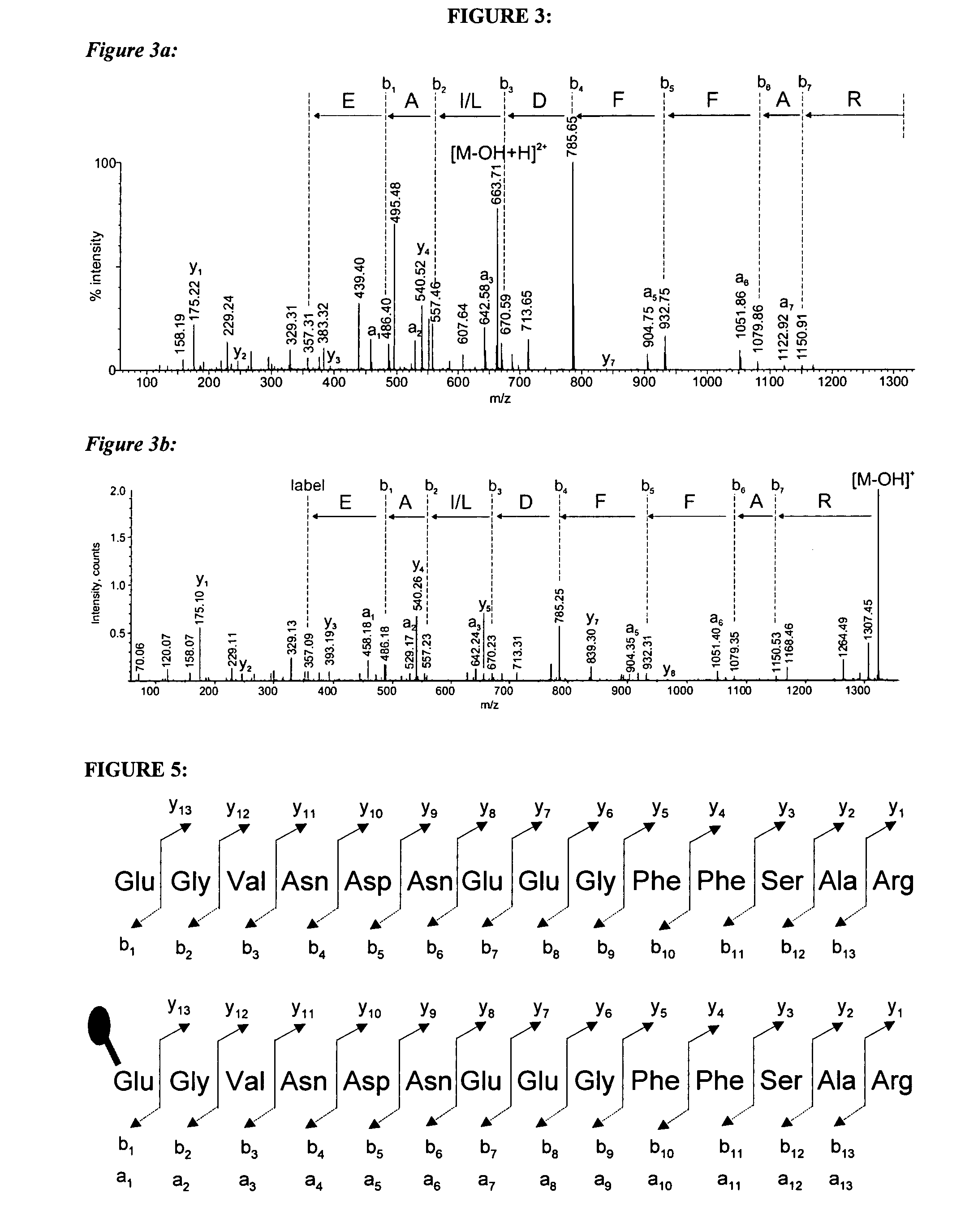Peptide mass spectrometry rich in daughter ions
a mass spectrometry and daughter ion technology, applied in the direction of isotope separation, material testing goods, particle separator tubes, etc., can solve the problems of reducing the efficiency of peptide mass fingerprinting, not always being able to unambiguously identify a protein, and often returning large number of false positive matches, etc., to facilitate the assignment of amino acid sequence information, improve the accuracy of results, and the effect of rapid assignmen
- Summary
- Abstract
- Description
- Claims
- Application Information
AI Technical Summary
Benefits of technology
Problems solved by technology
Method used
Image
Examples
example 1
Predominant Formation of Doubly Charged Molecular Ion
[0202] As illustrated by FIG. 1, the labels of the invention lead to predominant formation of doubly charged peptide ions in ESI-MS. Doubly charged ions are the preferred ions for fragmentation mass spectrometry, since they allow both N- and C-terminal daughter ions to be detected.
example 2
Identification of a, b and y Ions in MSn Spectra of Daughter Ions Derived From Fragmentation of Derivatised Peptides
[0203]FIG. 3 shows the ESI-Q-TOF-CID-MS / MS spectrum (FIG. 3a) and the MALDI-Q-TOF-CID-MS / MS spectrum (FIG. 3b) of the same peptide NH2-EALDFFAR-COOH (SEQ ID NO:3).
[0204] The parent ion selected for fragmentation mass spectrometry is highlighted. The parent ion selected in the ESI experiment is doubly charged, whereas that selected in the ESI experiment is singly charged.
[0205] In FIG. 3a, a complete b ion series (b1-b7) is visible and an almost complete a ion series (a1, a2, a3, a5, a6 and a7) is visible. In addition, a number of y ions are visible in the mass spectra of FIG. 3a. Accordingly, the mass spectrum shown in FIG. 3a permits rapid and simple assignment of an amino acid sequence to the peptide. Similarly, in FIG. 3b, a complete b ion series (b1-b7) is visible and an almost complete a ion series (a1, a2, a3, a5 and a6) is visible. In addition, a number of y ...
example 4
Identification of Proline Residues by Fragmentation Mass Spectrometry
[0209]FIG. 6 shows the MALDI-Q-TOF-CID-MS / MS mass spectrum of NH2-GPFPIIV-COOH (SEQ ID NO:4), a proline-containing peptide. As illustrated by that Figure, the presence of peaks corresponding to both a and b daughter ions in the mass spectra generated in the methods of the present invention is not affected by the presence of a proline residue in a derivatised peptide. Indeed, the peptide whose mass spectrum is shown in FIG. 6 contains two proline residues and yet it is still possible for an unambiguous amino acid sequence to be assigned to the peptide on the basis of the fragmentation mass spectrum.
PUM
| Property | Measurement | Unit |
|---|---|---|
| mass spectrometry | aaaaa | aaaaa |
| spectrum | aaaaa | aaaaa |
| fragmentation mass spectrum | aaaaa | aaaaa |
Abstract
Description
Claims
Application Information
 Login to View More
Login to View More - R&D
- Intellectual Property
- Life Sciences
- Materials
- Tech Scout
- Unparalleled Data Quality
- Higher Quality Content
- 60% Fewer Hallucinations
Browse by: Latest US Patents, China's latest patents, Technical Efficacy Thesaurus, Application Domain, Technology Topic, Popular Technical Reports.
© 2025 PatSnap. All rights reserved.Legal|Privacy policy|Modern Slavery Act Transparency Statement|Sitemap|About US| Contact US: help@patsnap.com



